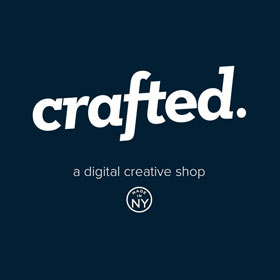
Crave-Worthy Digital Marketing Strategies for Restaurants: Captivate Your Customers!
They say the restaurant business is one of the most difficult industries to break into, let alone thrive in. That’s why you need to know how to push the odds in your favor.
The key to any successful business is knowing how to market to your audience. You need to answer important questions like “How will my community know I exist?” and “How can I attract people to my restaurant?”
Your answers lie in restaurant digital marketing. While some validity can be found in traditional means of advertising such as handing out flyers, direct mailing services, and radio commercials, the world has largely gone digital. If you don’t have an online presence, you might as well close up shop. Thus, we’re here to guide you through the essentials of digital marketing strategies for restaurants in this article.
Benefits of Digital Marketing for Restaurants
According to our research on digital marketing for food and beverage, 19.95% of brands in the industry seek help in digital marketing strategy development. Many brands recognize that implementing a comprehensive digital marketing plan can benefit restaurant owners in various ways. Let’s learn the top 3 benefits of digital marketing for restaurants’ journey to boost their sales:
Increased Visibility and Awareness
Food marketing campaigns created with a digital-first mindset allow you to reach a hungry crowd by improving your chances of attracting new customers and increasing brand recognition. Social media platforms like Facebook and Instagram, for example, offer highly effective advertising options that can be tailored to specific demographics. So, you can have a direct line to your customers’ taste buds with some digital marketing magic.
Improved Customer Engagement
Digital marketing helps you engage in two-way communication with your customers. And by keeping in touch with your customers through digital channels, you can foster a loyal following of foodies who keep coming back for more. As a result, they’ll leave glowing reviews, suggest your place to their friends, and become your biggest advocates.
Enhanced Customer Experience
You can create a seamless and personalized experience for your customers. For example, you can use digital ordering and delivery platforms to streamline and simplify the ordering process for your customers. Also, you can use the data you gather from these platforms to tailor your marketing campaigns for restaurants to your audience’s needs and preferences.
How to Do Digital Marketing for Restaurants
Running a restaurant is tough work, and with the rise of digital technology, having a strong online presence has never been more important. From perfecting your website to developing influencer marketing and email campaigns, there are countless ways to make your restaurant stand out in the digital world. If you’re unsure where to start or need expert guidance, we believe browsing through a digital marketing marketplace might be a good idea to find the right digital marketing agency, specializing in enhancing a restaurant’s online presence.
But don’t worry! We’ll also break down the essentials of digital marketing for restaurants and provide you with tips on how to get started. Whether you’re a seasoned pro or just beginning, let’s dive into digital marketing ideas for restaurants and get ready to make your business shine!
1. Perfect Your Website
Even though you own a local restaurant that’s anything but digital, your storefront is no longer the face of your company. When 88% of consumers go online to research products or services, they judge a business’s credibility based on its website above all else.
Your website needs to be professional, functional, and user-friendly to develop a solid digital marketing strategy. Potential customers need to navigate your site intuitively to find things like menus, hours of operation, and your address. Keep in mind that most people use their smartphones to research things like this, regardless of if they’re at home, in the car, at work, and so on – your website must be optimized for mobile devices.
Invest some time and money in professional pictures of your restaurant space, the food you offer, and your staff. The food will look more appetizing and your staff will appear more professional. It gives potential customers a sense of intimacy with your restaurant, even before they visit.

For example, UK-based hospitality marketing agency Propeller partnered with Zizzi, a chain with over 135 uniquely designed restaurants across the UK and Ireland, to enhance their customer experience. Through continuous analysis, optimization, and conversion strategies, Propeller developed a bespoke Bookatable integration and refined the menu development process, focusing on user experience. This comprehensive approach included a recent image optimization project, resulting in a 50% rise in target SEO KPIs, a 22% increase in new users, and a 53% growth in goal conversions within 12 months. These efforts not only improved Zizzi’s website functionality but also positioned them ahead of competitors, showcasing the power of a well-designed and optimized restaurant website in attracting and retaining customers
2. Focus on Local SEO
One of the most important steps in restaurant digital marketing is perfecting your search engine optimization. SEO is everything in terms of getting organic traffic to your website, and ultimately, customers in your seats. When someone types in “Italian restaurants near me,” your SEO rating will determine how quickly they find you.
To ensure that you have a perfectly working digital marketing strategy for your restaurant, you need to make sure your website’s SEO makes you a local hotspot. You can boost your SEO by taking the following actions:
- Create a blog on your website full of engaging and relevant content
- Make sure every page of your website utilizes local keywords and other forms of SEO coding (metadata embedded in pictures, videos, headings, etc.)
- Use internal links (to other pages of your site) and external links (to affiliate websites, sources of data, etc.)
- Create a Google My Business Account
- Make sure your contact information and address are listed multiple times and are easy to find
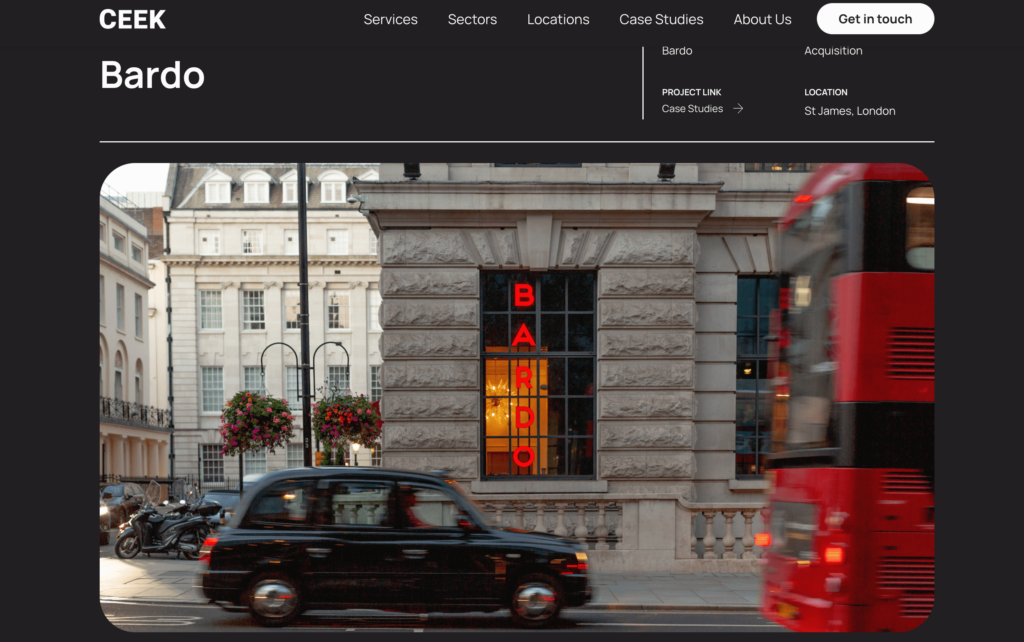
A great example of successful local SEO implementation is CEEK Marketing’s project with Bardo, an Italian restaurant offering a blend of fine dining and live music. CEEK Marketing revamped Bardo’s website to be more inviting and user-friendly, making it easier for diners to navigate and book tables. They didn’t stop there; they enhanced the restaurant’s digital marketing strategy by optimizing SEO and launching targeted Google Ads. The agency’s hard work significantly boosted Bardo’s visibility, resulting in more diners and a packed restaurant. It’s a prime example of how well-executed digital marketing strategies for restaurants can drive real-world results, attracting more people to experience Bardo’s unique ambiance and cuisine.
3. Gain Followers on Social Media
Having a website teeming with SEO coding is great (and necessary). However, there are some more proactive ways you can drive traffic to your site as well. Did you know that 69% of American adults are on Facebook? That means 69% of your potential customers can be found on Facebook.
A solid social media presence is a must for a successful digital marketing strategy for restaurants. Not only can you amass a following of people who are attracted to your restaurant and are likely to be repeat customers, but social media also provides effective networking opportunities. The best part is, you have plenty of options for both free and paid advertising campaigns.
For example, you can market cost-free on social media by hosting raffles or competitions offering free meals, gift cards, or even cash prizes to the winners. The key is to use the competition to extend your reach by encouraging users to like, comment, and share your posts. In turn, their followers will see the activity, be exposed to the competition, and likely start following your profile to compete for prizes as well.
Alternatively, you can look to paid social media marketing, which allows you to choose how much you spend per day toward your campaign as well as your target audience (based on age, gender, location, and more). This also comes with the perk of analytical data that breaks down the success and performance of your ads. You’ll be able to see how each ad performed in terms of engagement (link clicks, likes, follows, shares, comments) to help you fine-tune your advertisements.
4. Use Influencer Marketing
If you don’t yet have a strong following, or if you want to target a wider audience, consider influencer marketing. Social media influencers are those who have established credibility within certain industries or demographics, and as a result, often have thousands, if not millions of followers.
If there are any food-specific influencers in your relative location, it may not be a bad idea to reach out and invite them to eat at your restaurant for free. If they like your food, you can come up with an influencer marketing contract. In exchange for them to create a post about your restaurant, you can pay them a fee or give them a certain number of free meals.
One notable instance of successful influencer marketing and user-generated content is McDonald’s campaign in 2022. The marketing team introduced “The McD Challenge,” a digital marketing campaign that encouraged customers to create and share their unique meal combinations on social media. Accordingly, McDonald’s partnered with influencers as part of its marketing strategy, generating over 100 million views and more than 1 million pieces of content in total.
5. Implement Email Marketing
Another effective restaurant digital marketing strategy is called email marketing. First, you need to build an email list of recipients who have subscribed to your email. Gaining subscribers can be done by offering discounts to previous customers who subscribe, through social media, your website, affiliate websites, and landing page ads.
Once a customer subscribes, you need to have an automated set of emails that go out once or twice a week. These emails should be friendly and express gratitude to your subscribers while subtly pushing them toward coming back to your restaurant. However, they also need to contain valuable content (discounts, promotions), or people will stop opening them.
Email marketing has proven to be a top contender because it falls back on marketing to people who’ve already shown interest in or eaten at your restaurant.
6. Take Advantage of Online Reviews
Next, remember that most people need a little reassurance when it comes to investing in products or services, including dining experiences. When people research restaurants online, one of the things they’re looking for is what other customers have to say. You need to take advantage of online reviews and the level of credence consumers put in them.
Start by encouraging every paying customer to post a review on Google, your website, or on your social media profile. Most people need to be motivated to make a review; you can offer a respectable discount, a free drink, etc. once they’ve completed the review.
7. Network with Other Local Businesses
Another beneficial restaurant digital marketing strategy utilizes other small business owners in your area. Start building affiliate relationships with complementary businesses. You can work with one another by guest-posting on each other’s blogs, recommending their services, and more.
For example, connect with a local hotel and see if they will recommend your restaurant to travelers and other guests. They can do this in person and through their website. On your end, offer discounts to any customers who come to you through the hotel.
Alternatively, you can team up with other small businesses and offer discounts for business-related meals, such as salespeople meeting with current or potential clients, team luncheons, after-work parties, etc. The key is to offer value to other businesses that choose to affiliate with you. In return, you gain more customers and stronger influence within your community.
8. Develop a Strong Brand Identity and Creative Marketing Materials
Imagine walking into a restaurant where the décor, menu design, and even the music all come together to create a cohesive experience. That’s the power of a well-defined brand identity. It starts with a unique logo that reflects your restaurant’s essence and is consistently used across all platforms—your website, menus, signage, and marketing materials. But it doesn’t stop there. Your brand voice and messaging, the tone and style in which you communicate, should be consistent and align with what your customers expect from you. This creates a unified experience that customers can recognize and trust.
The atmosphere and interior design of your restaurant are equally crucial. They should reflect your brand’s personality and create an environment that complements your offerings. Whether it’s the cozy, rustic feel of a small café or the sleek, modern vibe of a fine dining establishment, the physical space should enhance the overall brand experience. Even the design and presentation of your menu play a significant role. A thoughtfully designed menu not only showcases your dishes but also reinforces your brand’s theme and style.
Take, for example, the work of The Charles with Gurney’s Star Island Premiere restaurant SHOWFISH. The Charles took inspiration from Montauk’s rich heritage as a “sleepy fisherman village” to create a brand identity that feels both authentic and modern. They crafted a logo that embodies this unique blend and extended the branding across various touchpoints, including menus, print materials, and even to-go bags.
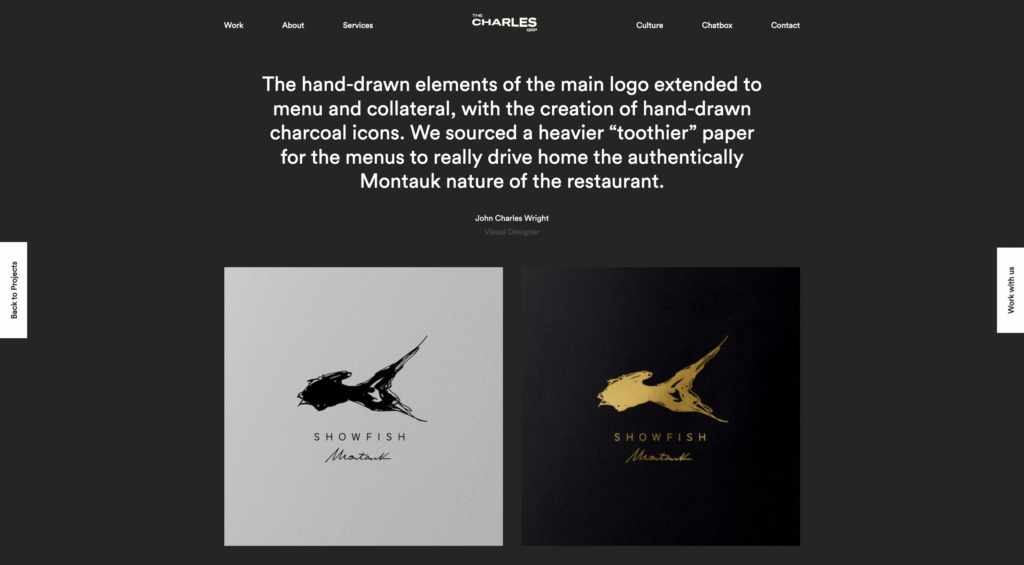
To bring the SHOWFISH concept to life, they incorporated organic textures and hand-drawn elements, complemented by modern typography and color accents. This combination was essential in developing a brand and digital experience that not only tells a compelling story but also encourages visitors to engage with the “sea-to-table” concept. The result was an immersive experience that invites customers to learn about and participate in the unique offerings of SHOWFISH.
9. Event Marketing and Community Engagement
In the restaurant industry, event marketing is a key strategy for connecting with customers and boosting brand awareness. Hosting or sponsoring special events gives restaurants the chance to showcase what they offer and create lasting memories for guests. Additionally, getting involved in the community, whether through partnerships with local businesses or participating in local events, helps build a loyal customer base and shows the restaurant’s commitment to the area.
As an example of this strategy, let us introduce you to Adtrak. The agency contributed significantly to the success of the Nottingham Restaurant & Bar Awards by focusing on effective branding and marketing. They developed a user-friendly website and produced promotional materials, like brochures and flyers, to raise awareness about the event. They also introduced an online voting system, making it easier for people to participate.
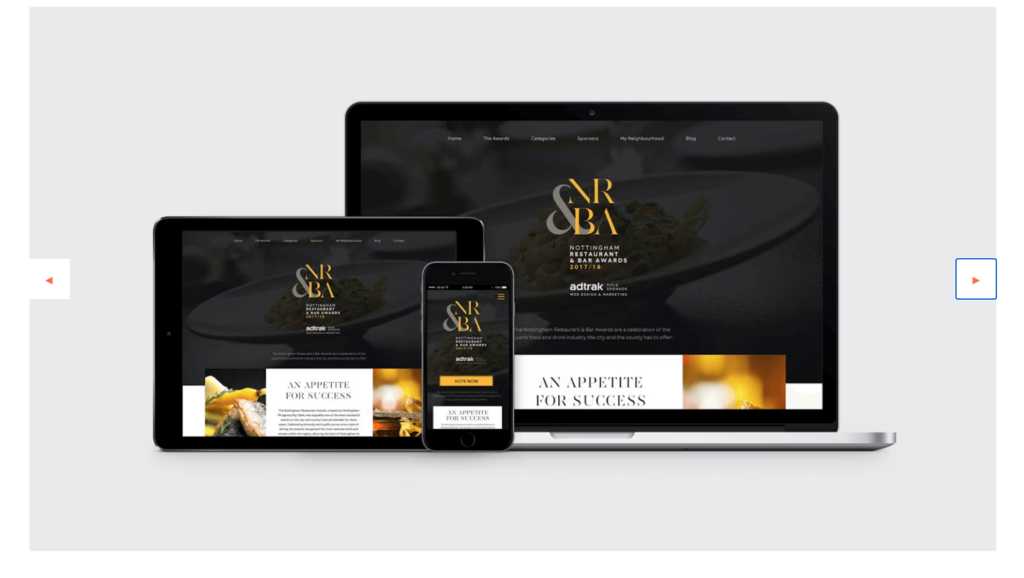
Additionally, Adtrak worked on improving the event’s social media presence and held workshops for local restaurants to help them with online engagement. Their efforts were crucial in increasing the event’s visibility and recognition in the hospitality industry, showcasing Adtrak’s skills in digital marketing.
10. Elevating User Experience and Conversion: From Luxury Branding to Seamless Bookings
Today, a restaurant’s online presence serves as the first point of contact for many customers. An effective user experience (UX) is key to making a strong impression and encouraging visitors to stay on the site. When a website is easy to navigate, users can quickly find the information they need, such as menus, hours, and reservation options. This seamless experience not only enhances customer satisfaction but also increases the likelihood of converting visitors into diners. A restaurant app development company can help restaurants build trust with their audience by ensuring that the website reflects the restaurant’s brand identity and provides a smooth booking process, ultimately encouraging repeat visits.
A great example of this strategy in action is Blacksmith’s work with The ONE Group for their STK restaurant brand. The ONE Group aimed to establish a web presence that communicated the luxurious lifestyle associated with their premium businesses. At the time, STK’s previous website lacked cohesive luxury brand guidelines, effective lifestyle blogging content, and a strong Instagram presence. These shortcomings led to low user engagement and below-average conversion rates for new reservations.
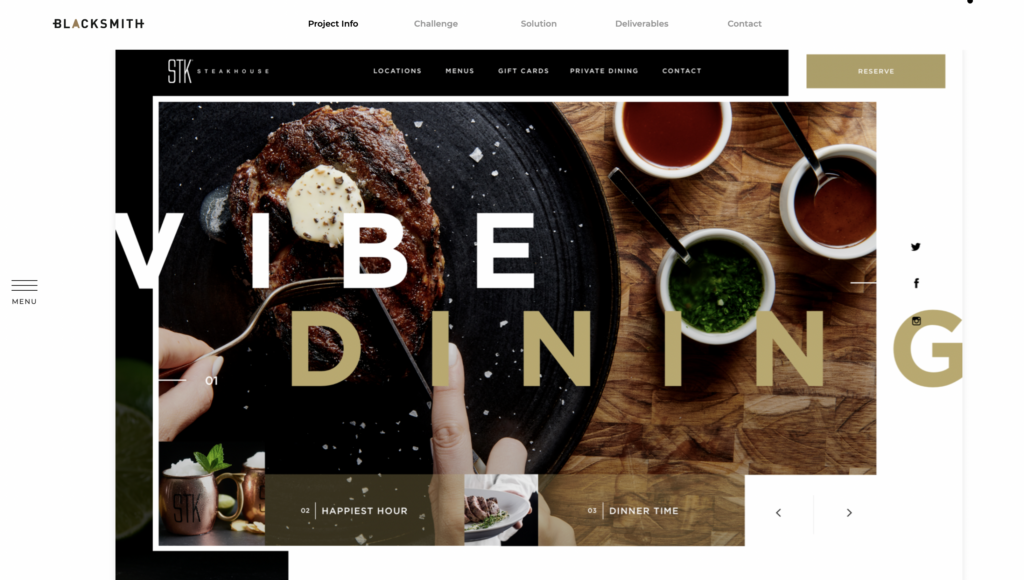
To address these issues, Blacksmith Agency recommended a comprehensive overhaul of STK’s digital presence. They focused on creating an intuitive UX/UI and implementing a seamless booking system. This approach included developing a website back-end built on WordPress, which allowed The ONE Group’s marketing team to easily add new locations and update pertinent information like events, menus, and city-specific content.
The results of these improvements were clear. STK experienced a notable increase in monthly traffic, with more users converting into reservations and private event bookings. This case demonstrates the importance of a cohesive digital marketing strategy that prioritizes user experience and smooth transactions, ultimately leading to greater customer satisfaction and business growth.
11. Keep Online Engagement High
Lastly, it’s important to understand that consistency is everything in restaurant digital marketing. If you want your community to remember your name when it comes time to grab a meal, you must make an effort to make it so. Running an advertising campaign once a year isn’t enough.
However, this doesn’t mean you have to break the bank to keep patrons coming back to your restaurant time and time again. It’s the little things like updating your website regularly, posting new content a few times a week on social media, and advertising new items on your menu. But remember, you have to keep the community involved by hyping up new specials online, running contests, and giving back.
Conclusion
As long as your food and service were good, you could set up shop on the street corner and do business for years. However, successfully marketing and engaging with the community requires a bit more intention
The learning curve for restaurant digital marketing can be steep, but we believe this guide can serve as your starting point!


